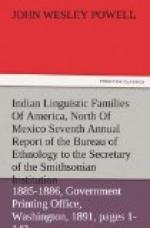The boundaries of the Athapascan family, as now understood, are best given under three primary groups—Northern, Pacific, and Southern.
Northern group.—This includes all the Athapascan tribes of British North America and Alaska. In the former region the Athapascans occupy most of the western interior, being bounded on the north by the Arctic Eskimo, who inhabit a narrow strip of coast; on the east by the Eskimo of Hudson’s Bay as far south as Churchill River, south of which river the country is occupied by Algonquian tribes. On the south the Athapascan tribes extended to the main ridge between the Athapasca and Saskatchewan Rivers, where they met Algonquian tribes; west of this area they were bounded on the south by Salishan tribes, the limits of whose territory on Fraser River and its tributaries appear on Tolmie and Dawson’s map of 1884. On the west, in British Columbia, the Athapascan tribes nowhere reach the coast, being cut off by the Wakashan, Salishan, and Chimmesyan families.
The interior of Alaska is chiefly occupied by tribes of this family. Eskimo tribes have encroached somewhat upon the interior along the Yukon, Kuskokwim, Kowak, and Noatak Rivers, reaching on the Yukon to somewhat below Shageluk Island,[7] and on the Kuskokwim nearly or quite to Kolmakoff Redoubt.[8] Upon the two latter they reach quite to their heads.[9] A few Kutchin tribes are (or have been) north of the Porcupine and Yukon Rivers, but until recently it has not been known that they extended north beyond the Yukon and Romanzoff Mountains. Explorations of Lieutenant Stoney, in 1885, establish the fact that the region to the north of those mountains is occupied by Athapascan tribes, and the map is colored accordingly. Only in two places in Alaska do the Athapascan tribes reach the coast—the K’naia-khotana, on Cook’s Inlet, and the Ahtena, of Copper River.
[Footnote 7: Dall, Map Alaska, 1877.]
[Footnote 8: Fide Nelson
in Dall’s address, Am. Assoc. Adv.
Sci.,
1885, p. 13.]
[Footnote 9: Cruise of the Corwin, 1887.]
Pacific group.—Unlike the tribes of the Northern group, most of those of the Pacific group have removed from their priscan habitats since the advent of the white race. The Pacific group embraces the following: Kwalhioqua, formerly on Willopah River, Washington, near the Lower Chinook;[10] Owilapsh, formerly between Shoalwater Bay and the heads of the Chehalis River, Washington, the territory of these two tribes being practically continuous; Tlatscanai, formerly on a small stream on the northwest side of Wapatoo Island.[11] Gibbs was informed by an old Indian that this tribe “formerly owned the prairies on the Tsihalis at the mouth of the Skukumchuck, but, on the failure of game, left the country, crossed the Columbia River, and occupied the mountains to the south”—a statement of too uncertain character to be depended upon; the Athapascan tribes




